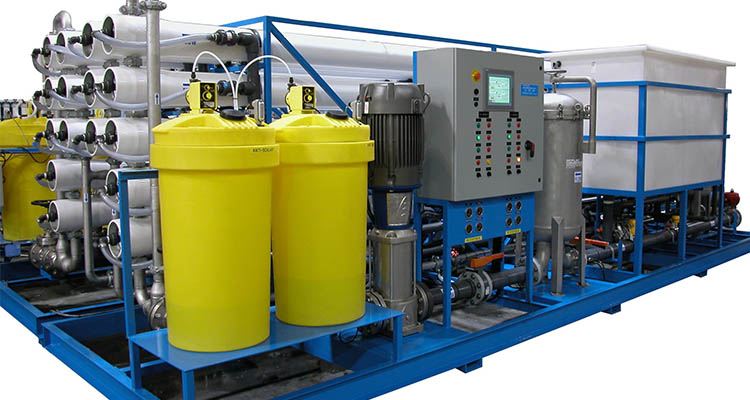Reverse Osmosis
What is a Reverse Osmosis (RO)?
The reverse osmosis is an interesting topic much discussed in the water treatment industry. With the lowest power requirements, some of the highest recovery rates, and one of the best rejection rates on the market, it’s no wonder people are interested in learning more about it. But what is it? How does it work? Let’s take a look at the heart of a Pure Aqua Reverse Osmosis System and break it down for a better understanding.
Reverse osmosis is the process of backward osmosis. Osmosis is the passage of water through a protein membrane (For example: like our skin or inside a plant cell) to equalize the concentration of dissolved particles in the water. The protein membrane allows water to pass through, but molecules larger than water (for example: things like minerals, salts, and bacteria) cannot pass. The water flows back and forth until the concentration is equal on both sides of the membrane, and an equilibrium is formed.
Let’s apply this knowledge to water purification. We want to drink water from a lake or stream, but it contains too high a concentration of contaminants such as salt, minerals, and bacteria, which make it impossible to drink. By applying pressure on water as it passes through a membrane, you can force the water away from the membrane rather than trying to achieve a balance like normal. This movement against flow is where the “reverse” in “reverse osmosis” comes from. A pump is an essential element for this process. Water is forced through the membrane, which, like a super fine particle filter, blocks the entry of most contaminants.
As a purification process, it has a number of advantages and disadvantages. In water treatment, TFC membranes can generally remove 96-99% of most contaminants, including salts and minerals, dyes, particulates, bacteria, and hazardous metals. However, because of the way reverse osmosis works, you can never really remove contaminants completely. It can purify up to a fraction of a fraction of a percentage, but the contaminant can never be completely removed with reverse osmosis. Treatment systems also require a high grade pump, because the rejection rate depends primarily on the pressure applied to the membrane. That said, the smaller units have smaller ratios of permeate (clean and purified product) to wastewater.
Now that we’ve answered the biggest question about Pure Aqua’s membrane systems , let’s take a closer look at how we build our advanced water treatment systems and how they work.

Types of commercial and industrial applications
If there is a need for water treatment, a reverse osmosis system can likely do the job. There are a wide range of industries that benefit from having high purity water, as well as a myriad of applications where water treatment is required. Due to the extreme volumes of water required, a reverse osmosis system is often the ideal and economical solution, requiring less energy than most large-scale treatment methods. Because they consume less energy, a reverse osmosis system is often also a green solution. At Pure Aqua, we pride ourselves on being a source of information and service that helps you solve your municipal, commercial or industrial water treatment needs.
- Pretreatment for boiler water
- Food and beverage services
- Food industry in general
- Pharmaceutical products
- Water bottling
- Industrial wastewater purification
- Hotels and hotel complexes (resorts)
- Ice making
- Car wash
What type of water supplies does a Reverse Osmosis System treat?
Reverse osmosis is an ideal water treatment solution in most water categories. Broadly speaking, all the main water sources from a treatment point of view can be divided into three main categories: tap water, also known as municipal source, ground water, which includes brackish water and salt water. The biggest distinction between these three types is the total dissolved solids content (TDS) of each type. As a general rule of thumb, the American Health Association requires that drinking water have less than 1000 ppm TDS.
Tap water usually comes through pre-existing infrastructure like city pipes or a dam system. Reverse osmosis is often used in a tap water environment to reduce hardness, or debris deposited in the water from running through metal pipes. Total dissolved solids is often a water purification target in tap water treatment systems. These types of reverse osmosis systems are ideal in locations such as power plants, pharmaceuticals, laboratories, and hospitals, where extreme water purity is crucial for industry. Tap water generally has a TDS of less than 1000 PPM.
Underground water reservoirs are often brackish or very brackish, meaning they contain large volumes of salt, but not enough to be considered salt water. Groundwater reverse osmosis is very common, and is one of the best uses of a reverse osmosis system to date. Groundwater is often purified for the agricultural industry, the mining industry, and for residential use. Groundwater is also a prized target of the bottling industry, because unique mineral combinations often taste attractive. Brackish water generally has a TDS of 5000 PPM or less, but can come in concentrations up to 12000 PPM.
Saltwater reverse osmosis (sometimes referred to simply as desalination) is the conversion of saltwater into potable water. Ocean water has up to 45,000 ppm TDS. Typically, for environmental reasons, a hole is dug in the ocean for this type of reverse osmosis, but an open intake is more useful. The biggest uses of desalination come from supplying water in areas that lack a regular supply of fresh water.
